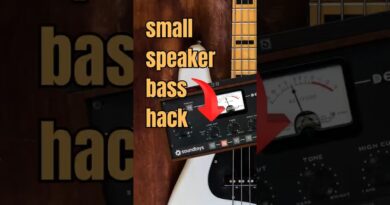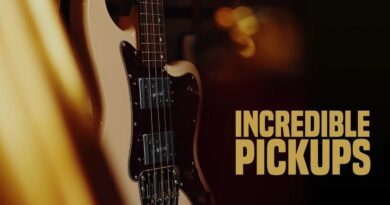Orchestration Tip: Timpani is (not) a Bass Instrument
100 MORE Orchestration Tips is available at:
For the most up-to-date orchestration analysis and additional resources and perspectives, please join me on Patreon.
https://www.patreon.com/orchestrationonline
Visit the official Orchestration Online website and subscribe to our newsletter. http://orchestrationonline.com
Join the orchestration online community by subscribing to this channel, checking in on Twitter @OrchestrationOL, and being part of the conversation on Facebook. https://www.facebook.com/groups/278568792265515/
#Orchestration #Tip #Timpani #Bass #Instrument
Originally posted by UCSt_ZRe_mla4tRgYC_GNElQ at https://www.youtube.com/watch?v=Zqm4Tf8c1dE




A super interesting video. Thank you. In this context, it is worth listening to the last bars of Betthoven's ninth slow movement, where the timpani and the double-bass imitate each other, playing the same notes.
I hope the aspiring arrangers read this book.
which recording did you use for the background piece "marche au supplice" from "symphonie fantastique"? i have never heard it played in that fast of a tempo
"balance on head, operate pedals with hands and kick timpani" ????
"…and lead not the orchestrator into the temptation of writing what doth computer sound samples can do, but deliver us from evils of a poorly written timpani part.'"
Hey. Sill question, but have to ask it. Should the pitch of the Timpani used be the same pitch a what's in the bass? So of C is in the bass of a C chord, it should be C. Similarly, if using a 2nd inversion where G is in the bass C/G, should G be used? Just general guidelines. Thx
I think I have both issues. I try not to make them change to fast, often making it a rather boring part. In addition to this, I tend to try and use every instrument all the time, which leads to Timpani being very constant.
I suppose that is something I will learn and refine with time. Thanks for the vids like these, they're very helpful to someone who has only ever written Concert Band or Small Ensemble pieces.
W video, very captivating
I think it's nice that timpani are tuneable but for myself, I would prefer not to use too many timpani in a score and to avoid tuning changes. The tuning mechanism certainly adds to the cost of the instrument and the more complex a construction is, the more likely it is that something will go wrong. I'd rather spend the money on aspects of the instrument that improve the actual sound. That's why I have a Bb and an F French horn and not a double horn. Of course, that limits what you can play, but there are always costs and benefits.
I am also somewhat suspicious of pedals on instruments, excepting the piano, effects pedals for electric guitar, etc., because of the time it takes to actuate them, e.g., harp pedals. A concert harp is out of my price range, to say nothing of a set of timpani, and the only instrument I have with pedals of this type is a pedal-steel guitar and it would definitely have to be carefully scored, if one wanted to have a player use the pedals and especially the knee levers.
I wouldn't want to require a player to have particularly fast hands or feet, nor would I want any score of mine to only be playable by professional musicians. The same applies to page turns, which I particularly dislike, not having particularly fast hands myself.
As a timpanist, I totally agree. Conductors such as Lorin Maazel have heavily (and unnecessarily) emended timpani parts of composers such as Beethoven, making them sound like Richard Strauss, and they lose their unique voice in the orchestra and instead become part of the string bass section.
2:52 1st timpanist A2, B2, E(!)3
Tis time to trim the timpani, thanks for the tip
To your very informative presentation , there is a wonderful companion set of videos done by the Principal timpanist of “The Orchestra Age of Enlightenment”. Covering the history of these drums, he manages to impart his enthusiasm and points out that In the hundreds of years that the orchestra has managed to add more and more players to broaden the sound as written by the many, many composers. in general, there is still the “One” timpani player. I said in general. Fascinating.
For anyone wondering, the backround music is "Symphonie fantastique (The March to the Scaffold)"
Some tymps you can't find a pitch in the tone, or the overtones suggest an entirely different pitch. But some are fully tonal. Undersized kettles for the note, head material, worn heads, too hard mallet? Just guesses.
where can i find the nibiru planets piece?
Me wanting to play careless whisper on timpani for my school talent show: well yes but actually no
Technically its one of those tuned bass percussion instruments
I don't know if I agree with your statement. Lots of parts were missing, especially in the Richard Strauss repertoire. Operas like Salome, Elektra, Rosenkavalier have tremendously influenced the repertoire. Everything has been a back and forth between good new instruments, good players and improvement in general. The timpani can be a great bass line instrument. And your exposition of the glissandi is exactly what a student should learn. There should be no excuses in the glissandi! It's practically a thing of honor
I think that the German timpani with the Berlin pedal, with sprocket and kalfskin help a lot in the true sound of these instruments. Unfortunately, the ludwig model "gas" pedal timpani that you are presenting do not offer the precision of the instruments that I am talking about.
So, the overall point is fine and needs to be said. Don't write melodies if you don't know what you are doing. But timpani are a bass instrument. I think the point you wanted to make was whether or not timpani are a tuned percussion instrument or a percussive string bass. Given their relatively aggressive articulation and noisy overtones, they should be treated like a percussion instrument.
But there are a lot of problems in the video. A lot of your historical information is inaccurate/misapplied. Some of your thoughts on performance practice are assuming the timpanists isn't a professional, such as the glissando conversation. It's roughly the same as saying you shouldn't write for trombone because they might glissando. Timpanists can sure as hell hide/eliminate a glissando. We have a number of tactics for doing it. Most college undergrads learn these skills.
I'm also always bothered by the overuse conversation about percussion. No other instrument has this asterisk over them. I would love to be treated like a part of the orchestra rather than a novelty.
Essentially, this video rides the line between making a good point and ensuring percussion writing doesn't advance to match the increasing capability of instruments and performers. I really wish this video was aimed more at how to write busy lines effectively rather than advocating that we don't advance and stay in the past.
Great video that answers so many questions I had about Timpani and how to score the instrument effectively
Our church's percussion player once filled in for the cello at a moment's notice, sight-reading parts from Haydn and Mozart, and pulled it off brilliantly with great sensitivity. But it's a good thing there was no Bach that morning. lol.
This should be obvious for any orchestrator but is a good reminder anyway
Your two examples were great for two different styles of writing that play to the Timpani's strengths.
The timpani is like a highlighter pen. You can use it for long, extended passages, or highlight a couple words every so often when you want to accentuate or mark the start of a given sentence. However, with either method, the more text gets highlighted, the less your eyes will be drawn to what's been highlighted. It becomes regular text all over again, only now there's an unnecessary color that's been added.
Melodic lines on timpani is an abomination.
Thank you for making this! So interesting!
You will note that the low F in the first full measure, and the Ab in the 3rd full bar are noticeably out of tune…..and I would quibble with the Dd and G# later in the passage….and the thing is….this passage was not badly played at all! So…if you are happy with near intonation….well then write like this…..(I always found Bartok far more interesting to play than to listen to….dont care much for his aesthetic)….
One should have told John Williams about such an approach….of course, his movie scores were meant to be done piecemeal in recording….not played straight through as a concert piece….you see top professional players using multiple timpani just to be able to play the parts….
I had this epiphany one day and it was so mind opening lol, but yeah I've noticed timpani is not really a BASS instrument.
I have a question: how many different notes can a timpani play ?
Great video! I will say on the Bartok that most players set the outside drums and just pedal the inner 2.
Richard Strauss didn't know that LOL…
Timpani is my favorite orchestral instrument…
"pseudoscientifically" is going into my scores tempo markings from now on.
*Confused melodic percussion noises
@UCSt_ZRe_mla4tRgYC_GNElQ
It would be awesome if the Timpani can Double the Bass line for tonal enhancement. You'd need a special set of Chromatic Timpani that can also play melodies and are ideal for transcription cause imagine hearing the Franck Violin Sonata played on the Timpani.
@UCSt_ZRe_mla4tRgYC_GNElQ
But you can have tuned timpani that are melodic. Here's Happy Birthday on Timpani Drums:https://www.youtube.com/watch?v=in0y-4_ax_s and it sounds very low
I just noticed your tempo marking and title page "The Extra Planets- Pseudoscientifically Q=123.7" lmao
Possibly related question: when arranging a piece for romantic orchestra w/timpani down to string orchestra, would you consider giving some of the timpani’s part to the double bass for example? Or would you just let it out? Thanks
I’m not a pro timpanist by any means, so when writing for people like me continuous pitch change is likely to result in terrifyingly bad intonation. If your piece needs a virtuoso timpanist you should expect it to be played correctly only in rare circumstances. Maybe at a prestigious premier by a very good orchestra will it sound right, but subsequent performances by students, community orchestras, semi-pros or other lower caliber players will be awful. There is generally not an over abundance of world-class timpani talent floating around.
Where can i find the piece at 5:47
I want to listen to these extra Planets from Gustav Holst?
when are we getting orchestration 105?
Thanks for making great videos. I think your videos are a major contributor to my improvement since last year as an orchestrator. I am orchestrating the Pathetique Sonata. I know Bruckner has already orchestrated the first movement of Pathetique Sonata op. 13, but the videos I find of this Bruckner orchestration always stop right at where the exposition goes into the development section. I have been told before that the changes that I have occuring with the predominant harmonies at beats 1 and 4 of each measure and the notes on the tympani will cause a tympani glissando. I am doubting it however, given how slow the tempo is in the section with quicker changes(tempo in that section is 30 BPM) Here are the first 4 measures of the Tympani part and the corresponding harmonies in the Beethoven sonata(also first 4 measures:
Tympani:
Bar 1: C, 2, 3, G, Bar 2: F, 2, 3, C, Bar 3: Eb, 2, 3, C, Bar 4: Eb, 2, 3, Bb
Harmony in Sonata:
Bar 1: Cm, 2, 3, G7, Bar 2: B°7, 2, 3, Cm, Bar 3: A°7, 2, 3, A°7, Bar 4, A°7, 2, 3, Bb7
The harmony might not be exactly correct in bars 3 and 4, but it illustrates my point. That is, that I am giving an accent to a harmony that is already there from the time that Beethoven wrote this sonata. Given that the tympani does nothing on beats 2 and 3 and that the tempo is at 30 BPM(that's where I tend to play the Pathetique Sonata introduction at), than even with the forte strike on the first beat, it should decay enough that there is no glissando on beat 4 and that likewise, the slow tempo combined with the quieter dynamic would mean no glissando into the next forte strike, right? It is only at faster tempos or in places where a tympani bass line fits that I have to worry about a glissando in the tympani, right?
By the way, the Bb is below the C in my tympani part. Should I have the tympani thusly tuned in Eb while the rest of the orchestra is playing in C minor? Or can the tympani pedal be used to lower the pitch as well as raise it? Or would the manual adjustment from C to Bb be fast enough given the slow tempo and then the adjustment back to C would have plenty of time given that until the Allegro, I give the tympanist a break?
Is it necessary to write "tune __ to __" or is that just left up to performers to figure out now?